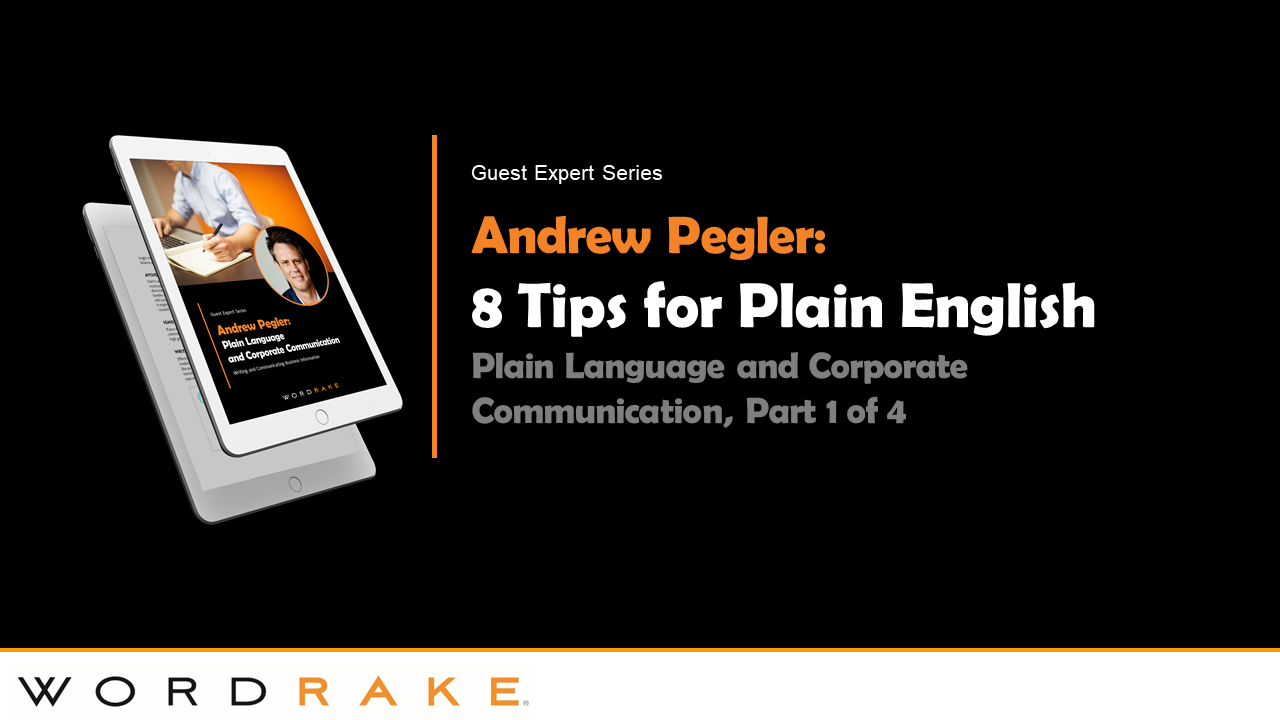Even if we’re winning at our job, know more than the average Joe, and are a member of an influential alma mater, clients and peers often judge us most by how well we write. In a nutshell—do they understand what we are saying? Success is a sure bet if we write well. Those skilled at unravelling verbiage, waffle, and corporate speak, who can relieve gobbledygook of its burden, cleave away self-importance, and medicate severity, are welcome in any team.
While speaking with elegance may not be in everyone’s power, simplicity and straightforwardness are. Usually when writing, what we say is not up to us. But the how? Well, that’s a different matter. It’s a chance to express ourselves… Enter, plain English.
Put simply—or dare I say it, plainly—plain English is writing something people understand at first reading. It’s clear, concise writing. It’s designed for scanning. It gets to the point and doesn’t alienate with jargon. It uses as few words as needed—but no less.
Plain English takes a little effort. We read a simple and effective message, but it’s usually the product of long and careful crafting. Mark Twain put it best when he started a letter to a friend with, “Sorry but I didn't have time to write you a short letter, so I have written a long one instead.” Communicating your points clearly so the reader can accurately interpret your meaning is the most important task in writing. Yes grasshopper, simplicity is the outward sign and symbol of depth of thought.
For twenty-some years, as a plain English writer/editor, I have honed my skills for keeping it simple—but no simpler—into eight tips. So, in no particular order, here goes…
1. Consider your audience
This is where it all starts for the plain English writer. What’s your core message? What’s your reader’s level of knowledge and interest? What generation are they from? How much time do they have? Are they chemical engineers or newly arrived immigrants with limited English? Use your intuition to hit the right tone and level of sophistication.
2. Keep it simple
Keeping it simple is not the same as dumbing down. You’re making it accessible—a courteous act people will love you for. Never discount your audience’s ability to understand complex ideas, but adjust your language to keep it simple.
3. Get punctuation and grammar right
You probably know the punctuation and grammar basics. In plain English, I find these things really help:
- correct use of apostrophes
- knowing when to capitalize
- proper use of acronyms
- making bullet lists so scanning is easier.
4. Use the active voice
A reader of text written in the passive voice may experience the communication as cool and formal. See what I did there? That was passive. I want you with me while you’re reading, so I favor the active voice!
5. Try for one idea per sentence
Shorter sentences with one main point are most effective. Think 20 or so words max. You don’t need to use an over-simplified style. Just try to make each sentence serve a specific purpose. And don’t fret—sometimes it’s just not possible.
6. If it’s not crucial, delete it
You might be so passionate about your subject that you want everyone who reads your stuff to be an expert too. In reality, most people won’t give two hoots. Ask yourself what information your audience really needs to know. Leave the rest out. This neatly circles us back to two things I’ve already mentioned:
- consider your audience
- keep it simple.
7. Don’t use jargon if there’s a plain English equivalent
Every profession, hobby, trade, sector, etc. has its jargon. Use it when talking to your tribe but—unless you feel it’s widely accepted—avoid it for non-specialist audiences, especially the general public. Your goal is not to alienate readers with language, but to bring them in to the tent. Keep this quote from Carlos Bueno in mind: “A little jargon doesn't look like much. Some people even keep them as pets. But they form packs, and they are very dangerous.”
8. If you have to look up a word’s meaning, don’t use it
It depends on your audience and what you’re writing about but generally, I think it’s best to avoid polysyllabic (long) words. See what I did there? Now for the pièce de résistance… “Floccinaucinihilipilification” is the longest word in the English language. Its etymology is mid 18th century from the Latin flocci, nauci, nihili, pili (words meaning ‘at little value’) + fication. Ironically, it means deciding something is worthless.
An ability to use plain English is the complete opposite!
About Andrew Pegler
Andrew Pegler is Principal of Andrew Pegler Media Ltd, an editorial and design agency specializing in keeping it simple. He is an award-winning plain English editor and writer and plain English workshop presenter. Andrew holds a bachelor's degree in communications and in economics. He also holds certificates in accounting, tax law, finance proofreading, editing, and public speaking. He is a regular presenter on plain English at conferences and summits in Australia and abroad.
Series on Plain Language and Corporate Communication
This is the first in a series of four articles on plain language and corporate communication by award-winning writer and editor Andrew Pegler. Make your writing easy for your readers by following these eight tips for plain English! WordRake can help—it's editing software that clarifies your meaning by finding opportunities to shorten your sentences and simplify your words. WordRake editing software is available for Microsoft Word and Outlook on Windows, or for Microsoft Word only on Mac. You can try it free for 7 days.









